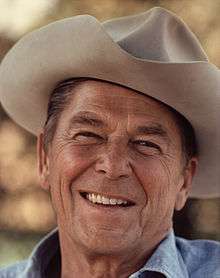1968 Republican Party presidential primaries
The 1968 Republican presidential primaries were the selection process by which voters of the Republican Party chose its nominee for President of the United States in the 1968 U.S. presidential election. Former Vice President Richard Nixon was selected as the nominee through a series of primary elections and caucuses culminating in the 1968 Republican National Convention held from August 5 to August 8, 1968, in Miami Beach, Florida.[2]
| |||||||||||||||||||||||||||||
| |||||||||||||||||||||||||||||
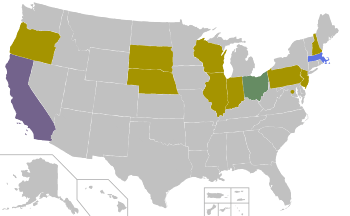 Gold denotes a state won by Richard Nixon. Blue denotes a state won by Nelson Rockefeller. Green denotes a state won by James A. Rhodes. Purple denotes a state won by Ronald Reagan. Grey denotes a state that did not hold a primary. | |||||||||||||||||||||||||||||
| |||||||||||||||||||||||||||||
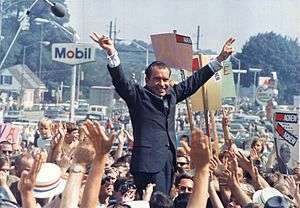
Schedule and results
| Date
(daily totals) |
Contest | Delegates won and popular vote[3] | |||
|---|---|---|---|---|---|
| Richard Nixon |
Ronald Reagan |
Nelson Rockefeller |
Other/Uncommitted | ||
| March 12 | New Hampshire | 80,666 (77.61%) |
362 (0.35%) |
11,241 (10.82%) |
11,669 (11.22%) |
| April 2 | Wisconsin | 390,368 (76.69%) |
7,995 (1.63%) |
50,727 (10.36%) |
40,763 (11.32%) |
| April 23 | Pennsylvania | 171,815 (59.65%) |
8,636 (3.00%) |
52,915 (18.35%) |
55,018 (19.00%) |
| April 30 | Massachusetts | (25.8%) |
(1.7%) |
(30.0%) |
(45.5%) |
| May 7 | Indiana | (100.0%) |
– | – | – |
| Ohio | – | – | – | 614,492 (100.0%) | |
| Washington D.C. | (90.11%) |
– | – | (9.89%) | |
| May 14 | Nebraska | (70.0%) |
(21.3%) |
(5.1%) |
(3.6%) |
| West Virginia | – | – | – | (100.0%) | |
| May 28 | Florida | – | – | – | (100.0%) |
| Oregon | (65.1%) |
(20.4%) |
(11.6%) |
(2.9%) | |
| June 4 | California | – | (100.00%) |
– | – |
| New Jersey | (83.4%) |
(3.2%) |
(13.4%) |
– | |
| South Dakota | (100.00%) |
– | – | – | |
| June 11 | Illinois | (78.1%) |
(7.1%) |
(9.7%) |
(5.1%) |
| Total pledged delegates (Popular vote) |
1,679,443 (37.54%) |
164,340 (3.67%) |
1,696,632 (37.93%) |
932,836 (20.86%) | |
- Italics - Write-In Votes
Candidates
The following political leaders were candidates for the 1968 Republican presidential nomination:
Major candidates
These candidates participated in multiple state primaries or were included in multiple major national polls.
| Candidate | Most recent position | Home state | Campaign | ||
|---|---|---|---|---|---|
| Richard Nixon | 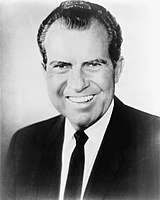 |
Former Vice President of the United States (1953–61) |
 California |
(Campaign) | |
| Ronald Reagan | .jpg) |
Governor of California (1967–75) |
 California |
||
| George W. Romney | .jpg) |
Governor of Michigan (1963–69) |
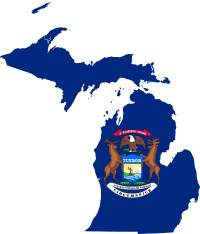 Michigan |
(Campaign) Announced: Nov. 18, 1967 Withdrew: February 28, 1968 | |
| Nelson Rockefeller |  |
Governor of New York (1959–73) |
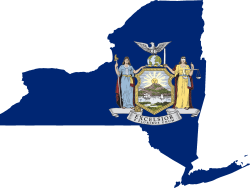 New York |
 (Campaign) | |
Favorite sons
The following candidates ran only in their home state's primary, caucus, or convention. They ran for the purpose of controlling their state's respective delegate slate at the national convention and did not appear to be considered national candidates by the media.
- Governor Spiro Agnew of Maryland (endorsed Nixon)[4]
- Governor Dewey F. Bartlett of Oklahoma (endorsed Nixon)[5]
- Senator Frank Carlson of Kansas[6]
- Senator Clifford Case of New Jersey[7]
- Governor Daniel J. Evans of Washington[8]
- Senator Hiram Fong of Hawaii (endorsed Nixon)[9]
- Governor Wally Hickel of Alaska (endorsed Nixon)
- Governor James A. Rhodes of Ohio (endorsed Rockefeller)[10]
- Governor Raymond P. Shafer of Pennsylvania (endorsed Rockefeller)[11]
- Senator John Tower of Texas (endorsed Nixon)[1]
- Senator Strom Thurmond of South Carolina (endorsed Nixon)[12]
- Governor John Volpe of Massachusetts (endorsed Nixon)[13]
Declined to run
The following persons were listed in two or more major national polls or were the subject of media speculation surrounding their potential candidacy, but declined to actively seek the nomination.
- Senator Everett Dirksen of Illinois
- Retired Lt. General James M. Gavin
- Senator Barry Goldwater of Arizona
- Senator Mark Hatfield of Oregon
- Governor Claude R. Kirk, Jr. of Florida (endorsed Rockefeller)
- Mayor of New York City John Lindsay (endorsed Rockefeller)
- Ambassador Henry Cabot Lodge Jr. of Massachusetts
- Senator Thruston Ballard Morton of Kentucky (endorsed Rockefeller)
- Senator Charles H. Percy of Illinois (endorsed Rockefeller)
- Former Governor William Scranton of Pennsylvania
- Representative Robert Taft Jr. of Ohio
Polling
National polling
Before November 1966
| Poll source | Publication | ||||||||||
|---|---|---|---|---|---|---|---|---|---|---|---|
| Gallup[14] | Jan. 10, 1965 | – | 18% | 15% | 27% | – | 14% | 6% | 8% | 9%[lower-alpha 1] | 3% |
| Gallup[15] | March 24, 1965 | – | 16% | 11% | 36% | – | 14% | 4% | 8% | 8%[lower-alpha 2] | 3% |
| Gallup[16] | June 27, 1965 | 7% | 14% | 13% | 25% | 3% | 11% | 6% | 7% | 11%[lower-alpha 3] | 3% |
| Gallup[17] | Sep. 26, 1965 | 5% | 12% | 9% | 28% | 2% | 15% | 7% | 8% | 9%[lower-alpha 4] | 8% |
| Gallup[18] | Oct. 1965 | 6% | 11% | 12% | 26% | 3% | 15% | 7% | 7% | 6%[lower-alpha 5] | 7% |
| Gallup[18] | Dec. 5, 1965 | 5% | 12% | 13% | 34% | 1% | 11% | 4% | 5% | 10%[lower-alpha 6] | 5% |
| Gallup[19] | Feb. 6, 1966 | 5% | 15% | 11% | 33% | 3% | 10% | 5% | 5% | 11%[lower-alpha 7] | 2% |
| Gallup[20] | April 10, 1966 | 7% | 12% | 13% | 27% | 4% | 14% | 5% | 6% | 3%[lower-alpha 8] | 9% |
| Gallup[21] | April 1966 | – | – | – | – | 11% | 34% | – | 17% | 18%[lower-alpha 9] | 20% |
| Gallup[21] | July 10, 1966 | – | – | – | – | 17% | 38% | – | 20% | 11%[lower-alpha 10] | 14% |
- Robert Taft Jr. with 4%, Mark Hatfield with 3%, and Charles Percy with 2%
- Robert Taft Jr. with 4%, Mark Hatfield and Charles Percy with 2% each
- John Lindsay with 5%, Robert Taft Jr. with 3%, Mark Hatfield with 2%, and Charles Percy with 1%
- John Lindsay with 3%, Robert Taft Jr. with 3%, Mark Hatfield with 2%, and Charles Percy with 1%
- John Lindsay with 2%, Robert Taft Jr. with 2%, Mark Hatfield and Charles Percy with 1% each
- John Lindsay with 4%, Robert Taft Jr. with 3%, Mark Hatfield with 2%, and Charles Percy with 1%
- John Lindsay with 4%, Robert Taft Jr. with 4%, Charles Percy with 2% and Mark Hatfield with 1%
- John Lindsay with 2% and Mark Hatfield with 1%
- John Lindsay with 11% and Mark Hatfield with 7%
- John Lindsay with 6% and Mark Hatfield with 5%
After November 1966
| Poll source | Publication | |||||||
|---|---|---|---|---|---|---|---|---|
| Gallup[22] | Nov. 25, 1966 | 31% | – | 8% | 39% | 5% | 11%[lower-alpha 1] | 7% |
| Gallup[23][lower-alpha 2] | Feb. 12, 1967 | 39% | 6% | 7% | 28% | 11% | 5%[lower-alpha 3] | 4% |
| Gallup[24] | March 19, 1967 | 39% | 4% | 8% | 30% | 9% | 6%[lower-alpha 4] | 4% |
| Gallup[25] | May 21, 1967 | 43% | 6% | 7% | 28% | 7% | 5%[lower-alpha 5] | 4% |
| Gallup[26] | July 12, 1967 | 39% | 7% | 11% | 25% | 10% | 4%[lower-alpha 6] | 4% |
| Gallup[27] | Aug. 23, 1967 | 33% | 6% | 15% | 26% | 12% | 5%[lower-alpha 7] | 3% |
| Gallup[28] | Aug. 22–26, 1967 | 35% | 6% | 11% | 24% | 14% | 4%[lower-alpha 8] | 6% |
| Gallup[28] | Sep. 15–19, 1967 | 40% | 9% | 16% | 14% | 17% | 2%[lower-alpha 9] | 2% |
| Gallup[29] | Nov. 19, 1967 | 42% | 5% | 13% | 14% | 15% | 6%[lower-alpha 10] | 5% |
| Gallup[30] | Jan 1968 | 42% | 5% | 8% | 12% | 27% | 4%[lower-alpha 11] | 2% |
| Gallup[30] | Feb. 21, 1968 | 51% | 3% | 8% | 7% | 25% | 5%[lower-alpha 12] | 1% |
| Gallup[31] | July 28, 1968 | 60% | 2% | 7% | – | 23% | 6%[lower-alpha 13] |
- Mark Hatfield with 3% and John Lindsay with 2%
- This poll was withdrawn from national newspapers by the Gallup organization after allegations of inconsistent methodology.
- Mark Hatfield with 3% and John Lindsay with 2%
- Mark Hatfield with 4% and John Lindsay with 2%
- Mark Hatfield with 3% and John Lindsay with 2%
- Mark Hatfield and John Lindsay with 2% each
- Charles Percy with 6%, John Lindsay with 3%, and Mark Hatfield with 2%
- Mark Hatfield and John Lindsay with 2% each
- Mark Hatfield and John Lindsay with 1% each
- Mark Hatfield and John Lindsay with 3% each
- Mark Hatfield with 2%, John Lindsay and James M. Gavin with 1% each
- Mark Hatfield with 2%, John Lindsay with 2%, and James M. Gavin with 1%
- John Lindsay with 4%, Mark Hatfield with 1%, and Harold Stassen with 1%
Head-to-head polling
Nixon v. Romney
| Poll source | Date(s) | |||
|---|---|---|---|---|
| Gallup[32] | Nov. 25, 1965 | 55% | 38% | 7% |
| Gallup[21] | July 10, 1966 | 55% | 40% | 5% |
| Gallup[33] | Nov. 1967 | 65% | 31% | 4% |
| Gallup[33] | Jan. 31, 1968 | 68% | 26% | 6% |
Statewide polling
New Hampshire
| Poll source | Publication | ||||
|---|---|---|---|---|---|
| Roper Research Associates[22] | March 4, 1968 | 65% | 9% | 13% | 13%[lower-alpha 1] |
Primary race
Nixon was the front-runner for the Republican nomination and to a great extent the story of the Republican primary campaign and nomination is the story of one Nixon opponent after another entering the race and then dropping out.
Nixon's first challenger was Michigan Governor George W. Romney. A Gallup poll in mid-1967 showed Nixon with 39%, followed by Romney with 25%. However, in a slip of the tongue, Romney told a news reporter that he had been "brainwashed" by the military and the diplomatic corps into supporting the Vietnam War; the remark led to weeks of ridicule in the national news media. As the year 1968 opened, Romney was opposed to further American intervention in Vietnam and had decided to run as the Republican version of Eugene McCarthy (The New York Times 2/18/1968). Romney's support slowly faded and he withdrew from the race on February 28, 1968. (The New York Times 2/29/1968).
Nixon won a resounding victory in the important New Hampshire primary on March 12, winning 78% of the vote. Anti-war Republicans wrote in the name of New York Governor Nelson Rockefeller, the leader of the GOP's liberal wing, who received 11% of the vote and became Nixon's new challenger. Nixon led Rockefeller in the polls throughout the primary campaign. Rockefeller defeated Nixon in the Massachusetts primary on April 30 but otherwise fared poorly in the state primaries and conventions.
By early spring, California Governor Ronald Reagan, the leader of the GOP's conservative wing, had become Nixon's chief rival. In the Nebraska primary on May 14, Nixon won with 70% of the vote to 21% for Reagan and 5% for Rockefeller. While this was a wide margin for Nixon, Reagan remained Nixon's leading challenger. Nixon won the next primary of importance, Oregon, on May 15 with 65% of the vote and won all the following primaries except for California (June 4), where only Reagan appeared on the ballot. Reagan's margin in California gave him a plurality of the nationwide primary vote, but when the Republican National Convention assembled, Nixon had 656 delegates according to a UPI poll (with 667 needed for the nomination).
Four candidates won states in the primary, a record not equaled in Republican primaries until 2016 when four candidates (Donald Trump, Ted Cruz, Marco Rubio, and John Kasich) won at least one state. (However, in 2012, three candidates (Mitt Romney, Rick Santorum, and Newt Gingrich) won states and a fourth (Ron Paul) won a contest in a territory, the Virgin Islands. For comparison, the 1968 Democratic primary saw five candidates win states.
Total popular vote
- Ronald Reagan – 1,696,632 (37.93%)
- Richard Nixon – 1,679,443 (37.54%)
- James A. Rhodes – 614,492 (13.74%)
- Nelson A. Rockefeller – 164,340 (3.67%)
- Unpledged – 140,639 (3.14%)
- Eugene McCarthy (write-in) – 44,520 (1.00%)
- Harold Stassen – 31,655 (0.71%)
- John Volpe – 31,465 (0.70%)
- Others – 21,456 (0.51%)
- George Wallace (write-in) – 15,291 (0.34%)
- Robert Kennedy (write-in) – 14,524 (0.33%)
- Hubert Humphrey (write-in) – 5,698 (0.13)
- Lyndon Johnson (write-in) – 4,824 (0.11%)
- George Romney – 4,447 (0.10%)
- Raymond P. Shafer – 1,223 (0.03%)
- William W. Scranton – 724 (0.02%)
- Charles H. Percy – 689 (0.02%)
- Barry M. Goldwater – 598 (0.01%)
- John V. Lindsay – 591 (0.01%)
The convention
At the 1968 Republican National Convention in Miami Beach, Florida, Reagan and Rockefeller planned to unite their forces in a stop-Nixon movement, but the strategy fell apart when neither man agreed to support the other for the nomination. Nixon won the nomination on the first ballot. Nixon then chose Maryland Governor Spiro Agnew to be his Vice-Presidential candidate, despite complaints from within the GOP that Agnew was an unknown quantity, and that a better-known and more popular candidate, such as Romney, should have been the Vice-Presidential nominee. It was also reported that Nixon's first choice for running mate was his longtime friend and ally, Robert Finch, who was Lt. Governor of California since 1967 and later his HEW Secretary, but Finch declined the offer and, in any case, had he run he would have put the Republican ticket at a disadvantage as the Constitution prevents a member of the Electoral College from voting for both President and Vice-President from the Elector's home state.
| President | (before switches) | (after switches) | Vice President | Vice-Presidential votes |
|---|---|---|---|---|
| Richard M. Nixon | 692 | 1238 | Spiro T. Agnew | 1119 |
| Nelson Rockefeller | 277 | 93 | George Romney | 186 |
| Ronald Reagan | 182 | 2 | John V. Lindsay | 10 |
| Ohio Governor James A. Rhodes | 55 | — | Massachusetts Senator Edward Brooke | 1 |
| Michigan Governor George Romney | 50 | — | James A. Rhodes | 1 |
| New Jersey Senator Clifford Case | 22 | — | Not Voting | 16 |
| Kansas Senator Frank Carlson | 20 | — | — | |
| Arkansas Governor Winthrop Rockefeller | 18 | — | — | |
| Hawaii Senator Hiram Fong | 14 | — | — | |
| Harold Stassen | 2 | — | — | |
| New York City Mayor John V. Lindsay | 1 | — | — |
Notes
- "widely distributed"
References
- "Nixon Gets Texas Votes--Enough for Nomination". The Atlanta Constitution. 2 Jul 1968. p. 11.
- "Guide to U.S. Elections - Google Books". Books.google.com. 2016-02-19. Retrieved 2016-02-19.
- "Chronology of Political Events: Nov. 1967—Nov. 1968." In CQ Almanac 1968, 24th ed., 19-974-19-978. Washington, DC: Congressional Quarterly, 1969. http://library.cqpress.com/cqalmanac/cqal68-1282597.
- Homan, Richard (6 Aug 1968). "Agnew Gives Nixon 16 Backers: Agnew Moves to Nixon Camp With 16 of 26 Md. Delegates May Be Decisive". The Washington Post. p. A1.
- Freeburg, Russell (5 Aug 1968). "Bartlett Withdraws, Indorses Nixon". The Chicago Tribune. p. 5.
- "G.O.P. WARDS OFF A SPLIT IN KANSAS: Leaders Believed Uniting on Carlson as Favorite Son". The New York Times. 14 Jan 1968. p. 25.
- "New Jersey G. O. P. Delegates Back Case". The Chicago Tribune. 23 July 1968. p. 5.
- Lembke, Daryl (23 June 1968). "Washington State GOP Gives Boost to Nixon". Los Angeles Times. p. 2.
- "Hawaii Slate To Back Fong". The Boston Globe. 12 May 1968. p. 24.
- "Rhodes Loses G. O. P. Slate in Ohio Area". Chicago Tribune. 14 May 1968. p. 3.
- Apple, R.W. (16 June 1968). "Rockefeller Wins Shafer's Endorsement: Expects to Gain Most of the 64 Delegates From Pennsylvania". The New York Times. p. 1.
- "Thurmond Stops Reagan, Holds South for Nixon: Thurmond Blocks Reagan's Threat to Nixon in South". Los Angeles Times. 7 Aug 1968. p. 1.
- "Gov. Volpe Backs Nixon Candidacy". The Austin Statesman. 28 June 1968. p. 48.
- Gallup, George (10 Jan 1965). "GALLUP POLL: Nixon Is Favored by GOP Rank-and-File as Leader". Los Angeles Times. p. J3.
- Gallup, George (24 March 1965). "GALLUP POLL: Nixon's Stock Up, Goldwater's Down". Los Angeles Times. p. 10.
- Gallup, George (27 June 1965). "Nixon Talies GOP Lead for 1968". Los Angeles Times. p. E3.
- Gallup, George (26 Sep 1965). "Nixon Leads in GOP; Romney Makes Gain". Los Angeles Times. p. F2.
- Gallup, George (5 Dec 1965). "Nixon Widening Lead Over GOP '68 Hopefuls". The Hartford Daily Courant. p. 19A.
- Gallup, George (6 Feb 1966). "Nixon Paces GOP Hopefuls". The Hartford Daily Courant. p. 23A.
- Gallup, George (10 Apr 1966). "Nixon Support Declines but He Still Tops GOP". The Hartford Daily Courant. p. 12A.
- Gallup, George (10 July 1966). "Romney Takes Lead Over Nixon in GOP Race". The Hartford Courant. p. 25A.
- "POLL SHOWS NIXON LEADS ROCKEFELLER". The New York Times. 4 Mar 1968. p. 18.
- "--But Gallup Poll Has Nixon in Front". Boston Globe. 14 Feb 1967. p. 15.
- "Nixon Leads Romney: Gallup Poll". The Boston Globe. 19 Mar 1967. p. 2.
- Gallup, George (21 May 1967). "Nixon Increases Lead Over Romney; Becomes Independents' First Choice". The Washington Post. p. A2.
- Gallup, George (12 July 1967). "Nixon Maintains Party Lead As Romney Support Declines". The Washington Post. p. A8.
- Gallup, George (23 Aug 1967). "Reagan Gains Strength, Still Trails Nixon, Romney With GOP Voters". The Washington Post. p. A21.
- "Gallup Poll: Reagan, Rocky Top Romney". Boston Globe. 24 Sep 1967. p. 23.
- Gallup, George (19 Nov 1967). "GOP Voters Give Nixon 3-1 Edge in Poll". Los Angeles Times. p. H1.
- Gallup, George (21 Feb 1968). "Gallup Finds Nixon Holds Wide Lead". Boston Globe. p. 1.
- Gallup, George (28 July 1968). "Nixon Clear Choice Over Rocky Among GOP Voters". The Hartford Courant. p. 26A.
- "Nixon Favored Over Romney In '68, Gallup Poll Reports". The New York Times. 25 Nov 1965. p. 58.
- Gallup, George (31 Jan 1968). "Nixon Gains on Romney; Lead Over Rocky Is Cut". The Washington Post. p. A2.
- Troy, Schlesinger & Israel 2012, pp. 1318-1319.
Bibliography
- Troy, Gil; Schlesinger, Arthur M.; Israel, Fred L. (2012). History of American Presidential Elections, 1789–2008. 3 (4 ed.). New York City: Facts on File. ISBN 978-0-8160-8220-9.
